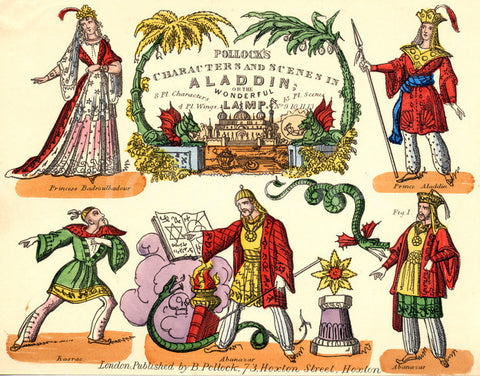You can also read this on my regular blog at the Homes & Antiques magazine website:

Pollock’s “Redington” Toy Theatre, 1960’s reprint from the Victorian original, in the collection of the V & A.
One Christmas- a long, long time ago- I bought a Pollock’s Toy Theatre with the yearly cheque sent by a kind godfather.
Oh, the excitement as the jaunty Harrods delivery van bounced up our rickety gravel drive! I must have been about ten years old. That Christmas my family was forced to watch several creaky performances of Jack the Giant Killer, with my long suffering little sister dragooned into reading the minor parts.

Pollock’s Toy Museum & Shop, Scala Street, London.
Later, as an undergraduate at University College, London, I discovered Pollock’s shop in a dingy back street off the Tottenham Court Road, and drawn, like a moth to candle, it became a regular haunt, as much because of its intoxicatingly archaic, dusty atmosphere- evoking the vanished, gaslit ambience of an Edwardian Never-Never Land.
Toy theatres were popular children’s toys until their decline at the end of the 19th century. Miniature prosceniums, characters, scenery and props were printed onto paper from copper plates and sold by publishers and stationers as individual sheets “a Penny Plain, or a Tuppence Coloured”. These could be cut out, pasted onto card or wood and then painted- if the child decided to plump for the cheaper option.

Children had a wide range of plays to choose from: Victorian melodramas, pantomimes and historical romances. The “actors” were mounted onto little tin slides and pushed onto the stage from the side wings. And sometimes, a play might include exciting stage tricks and effects, as in The Miller and His Men (1835), which included moving water and, disturbingly, realistic explosions (“red fire to burn”).
We can trace the early days of the English toy theatre to the first days of the Regency, when William West set up shop in Exeter Street, Covent Garden. By the 1880’s only two toy theatre publishers remained in London, Pollock in Hoxton, and Webb in Finsbury; and Benjamin Pollock’s shop, alone, struggled on as a quaint anachronism until his death in the 1930’s.

Urania Toy Theatre, Carl Bayer, Germany, circa 1885.
And with the decline of English toy theatre came the arrival of imported theatres from Germany and Denmark. If the populist charm of English toy theatre- “The Juvenile Drama”- had been enjoyed by children from a wider background, European theatres were more the preserve of children of the upper and upper middle classes: altogether grander and more sophisticated affairs, with magnificent prosceniums, sumptuous chromolithographic colour printing and operatic productions such as The Magic Flute.

Pollock’s “Hamlet, presented by Sir Laurence Olivier”, from the 1948 film, set and costume design by Roger Furse.
In 1944, Alan Keen, a raffish advertising man turned rare book dealer, bought up the entire stock of Pollock’s shop (including the original copper printing plates) and began republishing the plays and theatres. An interesting play from this period is Lawrence Olivier’s Hamlet, “reproduced from the J. Arthur Rank Enterprise” and published for the miniature stage in 1948. It featured colour-tinted photographic cutouts of a swashbuckling Sir Lawrence, and scenery and costumes taken directly from the film’s original set designs by Roger Furse.
Six years later, facing bankruptcy, the business was saved by the remarkable Marguerite Fawdry, who re-established Pollock’s in the attic of an old house in Monmouth Street, Covent Garden (later to move to Scala Street), but with the additional lure of a fascinating Toy Museum, which soon became a mecca for trendy parents searching for quirky presents for their ‘with it’ children in the Swinging London of the 1960’s.
Comments
Deb-
Thanks for your comment. I’ve sent you an email,
Best wishes, Luke
Posted by Luke Honey on December 18, 2015
Have loads of old toy theatre character and set sheets if you’re interested?
Posted by Deb on December 17, 2015
Post Comment